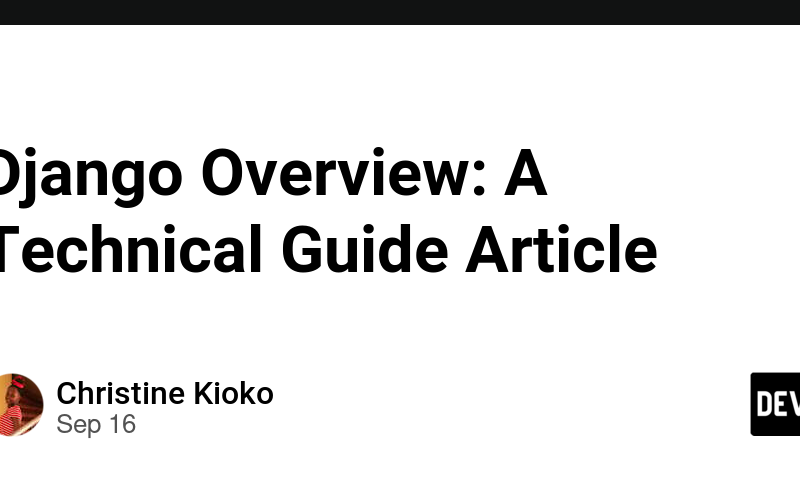Introduction to Django
Built-in Python, Django is an open-source, high-level web framework that promotes quick development and simple, straightforward interfaces. Is especially well-known for its extensive feature set, which includes user authentication, database administration, and URL routing, all of which simplify the building of online applications.
Django Overview: Installation, Project, and App Setup in Visual Studio Code
1. Installing Django in Visual Studio Code
Before starting a Django project, ensure you have Python and pip installed.
Step 1: Open Visual Studio Code (VS Code).
Step 2: Open the terminal (Ctrl + ~) and create a virtual environment to manage dependencies:
python -m venv env
Step 3: Activate the virtual environment:
Windows: envScriptsactivate
Step 4: Install Django using pip:
pip install django
2.Creating a Django Project
Once Django is installed, you can create a project.
Step 1: In the terminal, navigate to your working directory and run the following command:
django-admin startproject projectname
This creates a project folder with necessary Django files like settings.py, urls.py, etc.
Step 2: Move into your project folder:
cd projectname
Step 3: Run the development server to verify the installation:
python manage.py runserver
Open the browser to check the app installed.
3.Creating a Django App
In Django, an app is a module within a project that handles specific functionalities. To create an app:
Step 1: Inside the project directory, run:
python manage.py startapp appname
This creates a new directory called app with files for models, views, tests, etc.
Step 2: Register the app in myproject/settings.py by adding ‘app’ to the INSTALLED_APPS list:
INSTALLED_APPS = [
# Other apps...
'app',
]
- Creating a Simple View
To add basic functionality, you can define a view in your
app/views.py:
Step 1: Open app/views.py and create a simple view function:
from django.http import HttpResponse
def home(request):
return HttpResponse("This is my last two weeks task!")
Step 2: In projectname/urls.py, import the view and define a URL pattern:
from django.urls import path
from app import views
urlpatterns = [
path('', views.home),
]
- Running the Application
Step 1: Start the server again by running:
python manage.py runserver
Django’s architecture is made up of multiple important layers:
The Model Layer
Offers an abstraction for organizing and working with data. It addresses a variety of subjects, including migrations, queries (QuerySets), field types, models, and more complex database operations like transactions, raw SQL, and multiple databases.
View Layer:
This layer contains the logic that handles user queries and provides answers. It consists of class-based views, file uploads, view functions, URL routing, and middleware.
Template Layer:
Provides an information rendering syntax with features like tags, filters, and the template API that are helpful for both programmers and designers.
Form layer:
An extensive framework for generating forms, managing form data, and facilitating the use of form sets, custom validation, and media integration, among other advanced features.
Development Process layer:
Addresses deployment subjects such as WSGI/ASGI servers, testing, exception handling, application structure, and settings management in addition to the Django-admin tool.
Core Features of Django
-
MTV Architecture
Django follows the Model-Template-View (MTV) architecture, which is similar to the Model-View-Controller (MVC) pattern but with a different naming convention: -
Model:
Represents the data structure, typically stored in a database. -
Template:
Handles presentation, defining how data is displayed to users. -
View:
Manages the logic behind what data is presented to the user, interacting with the Model and rendering a Template. -
URL Routing Django
Provides a clean way to map URLs to views. It uses regular expressions (or the newer path converters) to define URL patterns that route HTTP requests to the appropriate view. -
Templates Django’s
The templating engine allows for dynamic HTML generation. The template system is designed to separate logic from presentation and includes features like template inheritance, filters, and tags for injecting dynamic content. -
Forms and Validation Django
Simplifies form handling by providing the forms module, which generates HTML forms, handles validation, and processes form submissions. The forms can be created manually or linked to models for automatic form generation. -
Admin Interface
One of Django’s most powerful features is its auto-generated admin interface. With minimal configuration, developers get a full-featured admin dashboard for managing application data, with functionalities like filtering, search, and object creation. -
Middleware
Middleware in Django is a framework for processing requests and responses. Each middleware component is executed in a sequence and can perform tasks such as session management, authentication, or modifying requests and responses. -
Authentication
System Django includes a robust authentication system out of the box. It supports user registration, login, password management, and permission handling. Authentication can be extended or customized as needed.
In summary
For programmers looking for a dependable and expandable platform , Django is a great option. Thanks to its inbuilt tools, security features, and DRY principle compliance, it’s a developer choice for quickly and effectively building both simple and complex apps. Django offers the framework and resources required for successful development, regardless of the type of project you are working on—a custom business application, a social media platform, or an e-commerce platform.
Source link
lol

